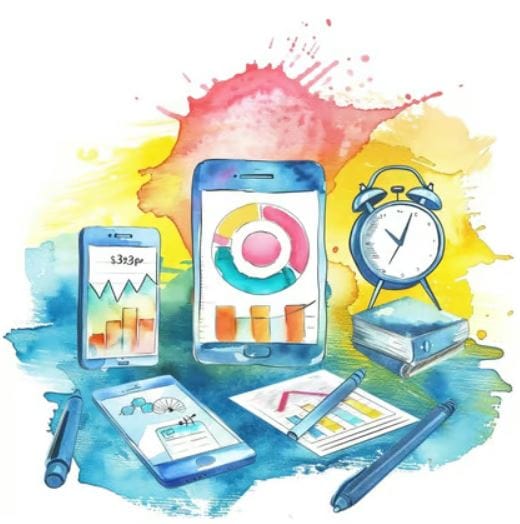The Conscious Screen Time Plan

At this point, I’m having a handful of conversations every week with people who are looking to build healthier relationships with their devices.
The common misconception is that ‘reducing screen time’ is the easy end-all-be-all solution to excessive technology use. That couldn’t be farther from the truth for a handful of reasons that I’ll go deeper on in later posts.
But the big one is that not all screen time is created equal.
Using Google Maps for three hours as I explore a new city or spend an hour FaceTiming a relative that lives across the country is far different from hurtling myself down a 2 hour TikTok brain rot rabbit hole. Even all social media screen time isn’t created equal. I’d take 3 hours over creating over 30 minutes of consuming any day of the week.
But unfortunately, Apple’s native Screen Time app gives you damn near no accurate data to work off of (and it’s certainly not nuanced) which makes getting a clear overview of your phone usage pretty hard. It also only lets you look back on a month of ‘rolling’ data. Not even month over month.
But most critically, most of this screen time data is inflated thanks to the infamous gray bar issue that Apple has yet to address after years of people begging them to do so.
(The total screen time displayed in-app is a lot higher than your actual screen time, if you were to add up the totals of each app individually. The ‘difference’ are these gray bars that nobody knows the true meaning of.)

Peep the gray bars
Anyway, here’s what they provide (with daily & weekly views) :
- A total screen time number
- Itemized screen time by app and app category
- Total notifications
- Total phone pickups
And unfortunately, because this data is locked within the ScreenTime API which Apple gives developers no choice but to build around, this is the same data that is fed into every screen time app.
(I can’t speak to Google’s Digital Wellbeing app since I don’t own an Android, but from what I’ve read it’s fairly similar.)
So, I built a solution to this problem. Yes it requires a bit of time and effort, but if you’re truly dedicated to making this change in your life (like myself and the people that I coach are), then this is the best way to get a clear view of your tech habits.
Step 1: Habit Tracker (15 min)
The habit tracker helps you get a clear picture of how much time you spend on specific apps each week and month. It’s not the prettiest spreadsheet, but you need this data to input into the Conscious Screen Time Plan (much prettier!).
Document Link: Here
- Go into the weekly view of your Apple Screen Time app and enter the name of every app that you used over the course of the week along with the app’s corresponding total weekly screen time.
- Do this for the past four weeks, writing each weekly total in the corresponding column. Do not duplicate apps (if you’ve used Instagram all 4 weeks, only write it once in Column A)
- You will see your monthly totals for each individual app in Column F

Example of a filled out Habit Tracker (fake numbers)
Step 2: Conscious Screen Time Plan (10 min)
The Conscious Screen Time Plan is the best tool (to my knowledge) to give you a true audit of your screen time. It’s also a great resource to help you build a plan to improve these numbers go forward.
Document Link: Here
1) Start by entering your total daily waking hours into the first box.
2) Next, you'll see two sections: Fixed Screen Time and Variable Screen Time (read more about the difference here). Enter each app's name, monthly total (numbers from Column F on the Habit Tracker), and purpose in the right section.
Simply put, fixed screen time is for essential apps you need for life or work, like Phone, Calculator, Maps, and Slack. This usage is pretty consistent over time. Variable screen time includes everything else, like social media and gaming, where usage can vary pretty heavily over time.
Some apps might fit into both categories. If that's the case, estimate how much time you spend on each and split the totals accordingly.

Entering in monthly screen time #s from the Habit Tracker into respective categories. You’ll see Messages and FaceTime fall into both buckets, so I split time across both.
3) These numbers will then populate a Current Summary section, where you’ll see your total monthly screen time broken down into fixed and variable, along with your monthly digital distraction ratio.

If you’re Digital Distraction Ratio is actually this high then please seek help lol
4) The next section will ask you a few questions to help you reflect on the data you’ve just uncovered and start thinking about potential goals.
5) Finally, the ‘Top 3 Time Consuming Apps’ section will automatically highlight your top three most time-consuming apps (from both fixed and variable categories) to help you identify areas where you can start to cut back.

6) Once you’ve filled everything out, click ‘Save as a Text File’ to download your information to keep on hand.
Bonus: SMART Goals Worksheet (10 min)
Once you’ve filled out the Conscious Screen Time Plan and you want to set actionable goals to track your progress, start by filling out the SMART Goals worksheet. This will help you set specific goals around both your screen time and how you’ll invest your newfound time. Just like the CSTP, you can save this as a text file to keep your info on hand.
Document Link: Here

That’s all for this week! Looking forward to seeing you put this into practice. If you have any questions, feel free to DM me on LinkedIn/Twitter or reply to this email.
Resources
Digital Wellness Coaching: If you’re interested in digital wellness coaching to help you build healthier, more intentional relationships with your technology (either individual or group), feel free to book a call here.
Digital Detox Tools: A free directory of 75+ digital wellness products, software, and services. Access it here.
Accountability Group: I’m creating an accountability group for people who are dedicated to reducing their screen time and building more intentional relationships with technology. It will be paid, but reasonable (gotta have some skin in the game). Reply to this email if you’re interested.
Contact Me: If any of my writing resonates with you, I’d love to hear from you. You can reply to this email or DM me on Twitter.
